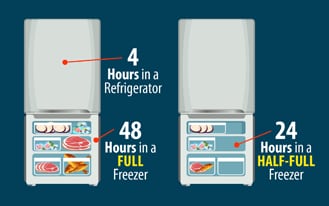What to know
Foods may be unsafe to eat after a disaster or emergency. To prevent foodborne illness, prepare for emergencies and take key steps during and after power outages, floods, and other emergencies.

Why it's important
If you are in a disaster or emergency, take steps to prevent illness from unsafe food. Refrigerated or frozen foods may not be safe to eat after a loss of power. Food that may have had contact with floodwater or storm water may also be unsafe to eat. Find out what you can do to keep food safe after an emergency or disaster.
Prepare for emergencies
- Keep appliance thermometers in your refrigerator and freezer. The refrigerator should be at 40°F or below. The freezer should be at 0°F or below.
- Freeze containers of water and gel packs to help keep food at 40°F or below.
- Have a cooler and frozen gel packs ready in case you have to remove food from the refrigerator to keep it cold.
- Buy dry ice or block ice to keep food cold in the refrigerator if you think the power could be out for a long time.
Steps to take during a power outage
- Keep refrigerator and freezer doors closed.
- If the doors stay closed, food will stay safe up to: 4 hours in a refrigerator, 48 hours in a full freezer, 24 hours in a half-full freezer.
- If the power has been out for 4 hours, and a cooler and ice are available, put refrigerated perishable foods in the cooler. To keep them at 40°F or below, add ice or a cold source like frozen gel packs.
Steps to take after a power outage
- Never taste food to know if it is safe to eat. When in doubt, throw it out.
- Throw out perishable food in your refrigerator (meat, fish, cut fruits and vegetables, eggs, milk, and leftovers) after 4 hours without power or without a cold source like ice. Throw out any food with an unusual smell, color, or texture.
- If you have an appliance thermometer in your refrigerator, check to see if it is still at 40 °F or below.
- Check temperatures of food kept in coolers or your refrigerator with an added cold source. Throw out food that has thawed or is above 40°.
- You can safely refreeze or cook thawed frozen food that still contains ice crystals or is at 40 °F or below.
- Check this FoodSafety.gov chart for a list of what foods you should throw out and foods you can refreeze.
Steps to take after a flood
Throw away these foods:
- Perishable food that has not been refrigerated or frozen properly due to power outages
- Food that may have come in contact with floodwater or stormwater
- Food with an unusual smell, color, or texture
- Food in packages that are not waterproof
- Food in cardboard containers, including juice/milk/baby formula boxes
- Food containers with screw caps, snap lids, crimped caps, twist caps, flip tops, and snap tops
- Home-canned foods and canned foods or food containers that are bulging, open, or damaged
- Throw out cans or food containers that spurt liquid or foam when you open them or contain food that is discolored, moldy, or smells bad
Unsafe food can make you sick even if it looks and smells normal. When in doubt, throw it out!
Clean and sanitize food-contact surfaces that have been flooded.
Throw out wooden cutting boards, baby bottle nipples, and pacifiers if they have come into contact with floodwaters. Sanitizing methods are not effective for removing contaminates in floodwater from these items. Clean and sanitize dishes, utensils, and other surfaces that touch food (like refrigerator drawers or kitchen countertops) in a four-step process:
- Wash with hot, soapy water.
- Rinse with clean, safe water.
- Sanitize: Make a solution of 1 cup (8 oz/240 mL) of unscented household chlorine bleach in 5 gallons of clean water. Soak items for 1 minute in the beach solution (solution should completely cover the items). For items that you can't put in the solution (like countertops), apply solution with a cloth.
- Allow to air dry.
How to salvage commercially prepared food in cans and plastic or metal pouches (like flexible, shelf-stable juice packages):
1. Remove labels if possible. Note the expiration date.
2. Brush or wipe away dirt or silt.
3. Wash cans and pouches with hot, soapy water.
4. Rinse cans and pouches with clean, safe water.
5. Sanitize cans and pouches in one of two ways: a. Place them in a solution of 1 cup (8 oz/240 mL) of unscented household bleach in 5 gallons of water for 15 minutes, OR b. Put in a pot of water, bring to a boil, and continue boiling for 2 minutes.
6. Re-label cans or pouches with a marker. Include the expiration date.
7. Use food in cans or pouches as soon as possible.
Resources
Printable Fact Sheet: Eat Safe Food after a Power Outage (English) (Spanish) (Additional Languages)
